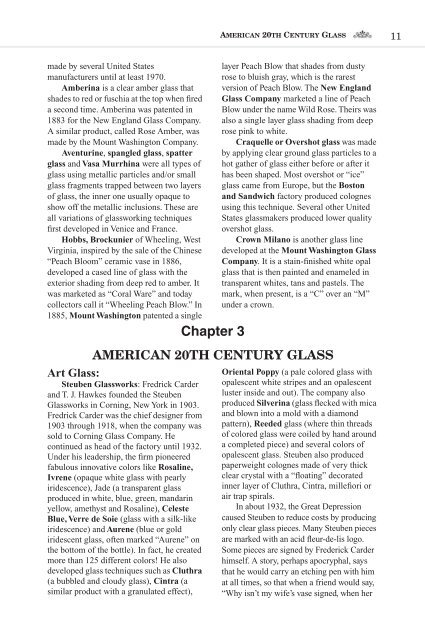Perfume Bottles
Kyle Husfloen, Penny Dolnick - Antique Trader Perfume Bottles Price Guide
Kyle Husfloen, Penny Dolnick - Antique Trader Perfume Bottles Price Guide
You also want an ePaper? Increase the reach of your titles
YUMPU automatically turns print PDFs into web optimized ePapers that Google loves.
AMERICAN 20TH CENTURY GLASS 11made by several United Statesmanufacturers until at least 1970.Amberina is a clear amber glass thatshades to red or fuschia at the top when fireda second time. Amberina was patented in1883 for the New England Glass Company.A similar product, called Rose Amber, wasmade by the Mount Washington Company.Aventurine, spangled glass, spatterglass and Vasa Murrhina were all types ofglass using metallic particles and/or smallglass fragments trapped between two layersof glass, the inner one usually opaque toshow off the metallic inclusions. These areall variations of glassworking techniquesfirst developed in Venice and France.Hobbs, Brockunier of Wheeling, WestVirginia, inspired by the sale of the Chinese“Peach Bloom” ceramic vase in 1886,developed a cased line of glass with theexterior shading from deep red to amber. Itwas marketed as “Coral Ware” and todaycollectors call it “Wheeling Peach Blow.” In1885, Mount Washington patented a singleChapter 3layer Peach Blow that shades from dustyrose to bluish gray, which is the rarestversion of Peach Blow. The New EnglandGlass Company marketed a line of PeachBlow under the name Wild Rose. Theirs wasalso a single layer glass shading from deeprose pink to white.Craquelle or Overshot glass was madeby applying clear ground glass particles to ahot gather of glass either before or after ithas been shaped. Most overshot or “ice”glass came from Europe, but the Bostonand Sandwich factory produced colognesusing this technique. Several other UnitedStates glassmakers produced lower qualityovershot glass.Crown Milano is another glass linedeveloped at the Mount Washington GlassCompany. It is a stain-finished white opalglass that is then painted and enameled intransparent whites, tans and pastels. Themark, when present, is a “C” over an “M”under a crown.AMERICAN 20TH CENTURY GLASSArt Glass:Steuben Glassworks: Fredrick Carderand T. J. Hawkes founded the SteubenGlassworks in Corning, New York in 1903.Fredrick Carder was the chief designer from1903 through 1918, when the company wassold to Corning Glass Company. Hecontinued as head of the factory until 1932.Under his leadership, the firm pioneeredfabulous innovative colors like Rosaline,Ivrene (opaque white glass with pearlyiridescence), Jade (a transparent glassproduced in white, blue, green, mandarinyellow, amethyst and Rosaline), CelesteBlue, Verre de Soie (glass with a silk-likeiridescence) and Aurene (blue or goldiridescent glass, often marked “Aurene” onthe bottom of the bottle). In fact, he createdmore than 125 different colors! He alsodeveloped glass techniques such as Cluthra(a bubbled and cloudy glass), Cintra (asimilar product with a granulated effect),Oriental Poppy (a pale colored glass withopalescent white stripes and an opalescentluster inside and out). The company alsoproduced Silverina (glass flecked with micaand blown into a mold with a diamondpattern), Reeded glass (where thin threadsof colored glass were coiled by hand arounda completed piece) and several colors ofopalescent glass. Steuben also producedpaperweight colognes made of very thickclear crystal with a “floating” decoratedinner layer of Cluthra, Cintra, millefiori orair trap spirals.In about 1932, the Great Depressioncaused Steuben to reduce costs by producingonly clear glass pieces. Many Steuben piecesare marked with an acid fleur-de-lis logo.Some pieces are signed by Frederick Carderhimself. A story, perhaps apocryphal, saysthat he would carry an etching pen with himat all times, so that when a friend would say,“Why isn’t my wife’s vase signed, when her


